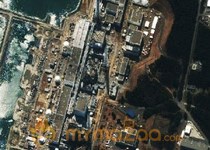External power reached all six reactors Tuesday at a damaged nuclear power plant in northeastern Japan, 11 days after an earthquake and tsunami rocked the region, raising hopes that meltdowns could be averted, a news report said.
External power began to be hooked up to the plant in Fukushima prefecture Sunday and the final two reactors, number 3 and 4, at the plant were connected Tuesday, the Kyodo News agency reported. The plant’s operator, Tokyo Electric Power Co (TEPCO), is trying to restore power at the overheating reactors to revive key functions in their control rooms.
TEPCO’s efforts were suspended Monday after gray smoke rose from the reactor 3 building, 250 km northeast of Tokyo.
Defence Minister Toshimi Kitazawa told reporters Tuesday that the smoke from reactor 3 was likely from burning debris while the “smoke” seen coming from reactor 2 was steam.
Steam is produced when water cools the overheating rods of nuclear fuel.
Fire trucks resumed their operations to cool the reactors, showering tonnes of water onto spent-fuel storage pools at the reactors.
Tokyo Fire Department trucks doused the pool of reactor 3 after the cooling systems at all six reactors failed when the plant was swamped by the March 11 tsunami, which was believed to have been as high as 14 metres and which knocked out power.
TEPCO vice president Norio Tsuzumi visited a shelter housing evacuees from Okuma town, where the troubled plant is located, and apologised.
“TEPCO is to blame,” Tsuzumi said. “I apologise for causing the trouble to the region, the people in Fukushima and society.”
Evacuees at the shelter in Fukushima’s Tamura city told Tsuzumi how they wished to return home.
Another apology came from Industry Minister Banri Kaieda over reports that he threatened to “punish” firefighters if they refused to participate in the operation.
“If my remarks offended firefighters, I would like to apologise on that point,” Kaieda said while refraining from touching on the question whether he had actually made such remarks.
Two German-made pumping vehicles also joined the operation for the first time, dumping tonnes of water onto the pool of reactor 4 from a height of 50 metres. The vehicles, the M52 Multi-Z, made by Putzmeister Holding GmbH, were offered by a Mie-based contractor to TEPCO.
Two armoured vehicles were to be mobilised Tuesday to remove rubble at the plant, which has hampered the cooling operations.
Officials of the US Nuclear Regulatory Commission said Monday that conditions at the plant seem to have improved although frantic attempts to regain control of the stricken reactors are continuing.
“The fact that off-site power is close to being available for use by plant equipment is the first optimistic sign that things could be turning around,” Bill Borchardt, head of the commission’s operations, said in a public meeting Monday in Washington.
Meanwhile, TEPCO said radioactive iodine at levels 126.7 times higher than the legal limit and radioactive cesium 24.8 times higher were detected in seawater near the plant.
That was believed to have been caused by the nuclear accident, company officials said.
The government told four prefectures – Fukushima, Ibaraki, Tochigi, Gunma – to restrict shipments of spinach and “kakina,” a leafy vegetable, as levels of radioactive substances in the produce surpassed legal limits. Tokyo also told Fukushima to suspend shipments of raw milk.







